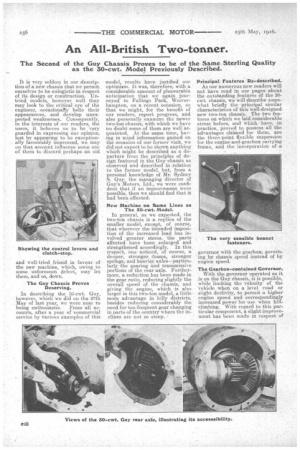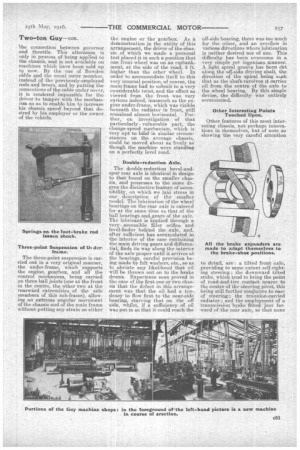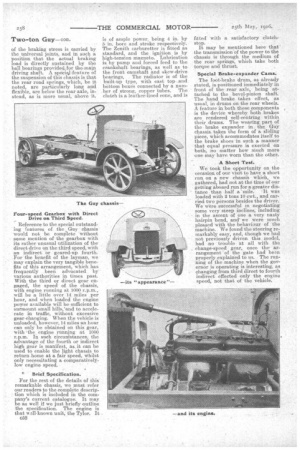An All-British Two-tonner.
Page 14

Page 15

Page 16

If you've noticed an error in this article please click here to report it so we can fix it.
The Second a the Guy Chassis Proves to be of the Same Sterling Quality as the 30-cwt. Model Previously Described.
It is very seldom in our description of a new chassis that we permit ourselves to be eulogistic in respect of its design or construction. Untried models, however well they may look to the critical eye of the engineer, occasionally belie their appearances, and develop unexpected weaknesses. Consequently, in the interests of our readers, the users, it behoves us to be very guarded in expressing our opinion, lest by appearing to be exceptionally favourably impressed, we May on that account influence some one of them to discard perhaps an old and well-tried friend in favour of the new machine, which, owing to some unforeseen defect, may let them, and us, down.
The Guy Chassis Proves Deserving.
In describing the 30-cwt. Guy, however, which we did on the 27th May of last year, we were near to
being enthusiastic. From all accounts, after -a year of commercial service by Various examples of this model, results have justified our optimism. It was, therefore, with a considerable amount of pleasurable anticipation that we again journeyed to Fallings Park, Woiyerhampton, on a recent occasion, so that we might, for the benefit of our readers, report progress, and also personally examine the newer two-ton chassis, with which we have no doubt some of them are well acquainted. At the same time, having in mind information gained on the occasion of our former visit, we did not expect to be shown anything which might be described as a departure from the principles of design featured in the Guy chassis. as observed and described in relation to the former model, but, from a personal knowledge of Mr. Sydney S. Guy, the managing director of Guy's Motors, Ltd., we were confident that if an improvement were possible, then we should find that it had been effected.
New Machine on Same Lines as The 30-cwt. Model.
In general, as we expected, the two-ton chassis is a replica of the smaller model, except, of course, that wherever the intended imposition of the increased load has involved greater stress, the parts affected have been enlarged and strengthened accordingly. In this , respect, one noticed, of course, a deeper, stronger frame, stronger springs, and heavier axles—particu larly. the gearing and transmissive portions of the rear axle. Furthermore, a reduction has been made in the gear ratio, reducing slightly the oyerall speed of the chassis, and giving the engine, which is also larger in this two-ton model, a littlemore advantage in hilly districts, besides reducing considerably the need for too-frequent gear changing in parts of the country where the inclines are not so steep.
Principal Features Re-described. .
As our numerous new readers will not have read in our pages about the outstanding features of the 30cwt. chassis; we will describe somewhat briefly the principal similar characteristics of this well-designed. new two-ton chassis. The two features on which we laid considerable stress before, and which have, in practice, proved to possess all the advantages claimed for them, are the three point flexible suspension for the engine-and-gearbox carrying frame, and the incorporation of a governor with the gearbox, governing by chassis .speed instead of by engine speed.
The Gearbox-contained Governor. With the governor operated as it is on the Guy chassis, it is possible, while limiting the velocity of the Vehicle when on a level road: or slight declivity, to permit a higher . engine speed and correspondingly increased power for use when hillclimbing. With regard to this particular component, a slight improvement has been made in respect of
the connection between governor and throttle. This alteration is only in process of being appliedto the chassis, and is not available on machines which have been sold ap to now. By the use of Bowden cable and the usual outer member, instead of the previously-employed eads and levers, and by putting the aonnections of the cable under cover, it is rendered impossible for the driver to tamper with the mechanism so as to enable him to increase his chassis speed beyond that desired by his employer or the owner of the vehicle.
Three-point Suspension of Older . frame.
The three-point suspension is carried out in a very original manner, the under-frame which supports the engine, gearbox, and all the control mechanism, being carried on three ball joints (one at the front -in the centre, the other two at the rearward extremities of the side members of this sub-frame), allowing an extreme angular movement of the chassis and of the main frame without putting any strain on either
the engine or the gearbox. As a demonstration in the utility of this arrangement, the driver of the chassis of which we made a personal test placed it in such a position that one front wheel was on an embankment, at the side of the road, 2 ft. higher than the other wheel. In order to accommodate itself to this very unusual position, of course, the main frame had to submit to a very considerable twist, and the effect as viewed from the • front was very curious indeed, inasmuch as the engine under-frame, which was visible beneath the radiator in front, still remained almost horizontal. Further, on investigation of that particularly vulnerable part the change-speed mechanism, which is very apt to bind in similar circumstances on the average chassis, could be moved a-bout as freely. as though the machine were standing on a perfectly level road.
Double-reduction Axle.
The double-reduction bevel-andspur rear axle is identical in design to thatfound on the smaller chassis, and possesses to the same degree the distinctive feature of accessibility, on .which we laid stress in our description of the smaller model. The lubrication of the wheel bearings on the rear axle is catered for at the same time as that of the ball bearings.and;sears of the axle. The lubricant is Applied through a very Aceessible filler orifice and level-finder behind the axle, and, after sufficient has accumulated in the interior of the case containing the main driving gears and differential, finds its way along the interior of the axle proper until it arrives at the bearings, careful provision being made by felt washers, etc., so as to obviate any likelihood that oil will be thrown out on to the brake drums. Experience soon proved in the case of the first one or two chassis that the defect in. this .arrangement was that the oil -had a tendency to flow first to the near-side bearing, starving that on the off side, whilst, if a sufficiency of oil was put in so that it could reach the off-side bearing, there was toe much for the other, and an 'overflow in various directions where lubrication is neither desired nor of use. This difficulty has been overcome in a very simple yet ingnaiolls, manner. A light spiral groove has been eut along the off-side driving shaft, the direction of the spiral being such that as the shaft, revolves it carries oil from the centre of the axle to the wheel bearing. By this simple device, the difficulty was entirely surmounted.
Other Interesting Points Touched Upon.
Other features of this most interesting chassis, not perhaps innovations in themselves, but of note as showing the very careful attention
to detail, are : a tilted front axle, providing to same extent self-righting steering ; the downward tilted stubs, which tend to bring the point of road-and-tire .contact nearer to the centre of the steering pivot, this being still further conducive to ease of steering ; the trunnion-carried radiator ; and the employment of a transmission brake fitted just forwardof the rear axle, so that none
of the braking stress is carried by the universal joints, and in such a position that the actual braking load is directly sustained by the ball bearings provided, for the,inatn
driving shaft. A spec' 'feature of the suspension of this chassis is that the rear road springs, which, be it noted, are particularly long and flexible, are below the rear axle, instead, as is more usual, above it.
Four-speed Gearbox with Direct Drive on Third Speed.
Reference to the special outstanding features of the Guy ohassis would net, be complete without sqme mention of the gearbox with its rather unusual utilization of the direct drive on the third speed, with an indirect or geared-up fourth. For the benefit of the layman, we may explain the very tangible benefits of this arrangement, which has frequently been advocated by various authorities in times past. With the third or direct gear engaged, the speed of the chasSis, with engine running at 1000 r.p.m., will be a little over 14 miles per hour, and when loaded the engine power available will be -sufficient to surmount small hills, and to accelerate in traffic, without excessive gear-changing. When the vehicle is unloaded, however, 14 miles an hour can only be obtained on this gear, with 'the. engine running at 1000 r.p.m. In such cireunistances, the advantage of the fourth or indirect high gear is manifest, as, it can be used to enable the light chassis to return home at a fair speed, whilst only necessitating a comparativelylow engine speed.
• Brief Specification.
For the rest of the details of this remarkable chassis, we must refer our readers to the complete description which is included in the company's current catalogue. It may be as well if we just briefly outline the specification. The engine is that Ns ell-known unit, the Tylor. It 052 is of ample power, being 4 in. by 5 in. bore and -stroke re,speotively. The Zenith carburetter is fitted as standard,, and the ignition is by high-tension magneto. Lubrication is by pump and forced feed to the crankshaft bearings, as well as to the front camshaft and skew-drive bearings. . The radiator is of the built-up type, with east top and bOttom boxes connected by a number of strong, copper tubes. The clutch is a leather-lined cone, and is fitted with a satisfactory clutchstop. It may be mentioned here that the transmission of the power to the chassis is through the mediuna of the rear springs, which take both torque and thrust.
Special Brake-expander Cams: The foot-brake drum, as already stated, is positioned immediately in front of the rear axle, being attached to the bevel-pinion shaft. The hand brake takes effect, as usual, in drums on the rear wheels. A feature in both these components is the device whereby both brakes are rendered self-centring withm their drums. The wearing part of the brake expander in the.Guy chassis. takes the form of a • sliding piece, which accommodates itself to the brake shoes in such a manner that equal pressure is exerted on both-, no matter how much more one may have Worn than the other.
A Short Test.
We took the opportunity on the occasion of our visit to have a, short run on a. new chassiS which, we gathered, had not at the time of our getting aboard run for a greater distance than half a' mile. ‘It was loaded with 2 tons 10 cwt., and carried two persons besides the driver. We were successful in negotiating some very steep inclines, including
in the ascent of one a very nasty hairpin bend, and we were much pleased with the behaviour of -the machine. We found the steering remarkably easy, and, though we had not previously driven this model, had no trouble at all with the
. change-speed. gear, once thc,. arrangement of the gate had been properly explained to us. The running of the machine when the governor is operating is interesting, as. .. changing from third direct to fourth. indirect effected only the engine speed, not that of the vehicle.




















